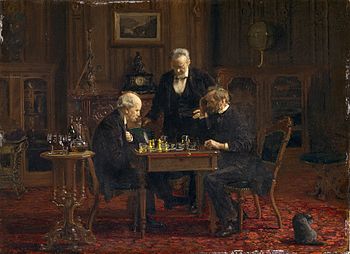|
'''''The Chess Players''''' is a ] of 1876 by American artist ] (1844–1916). It is a small oil on wood panel depicting Eakins' father Benjamin observing a ] match. The two players are Bertrand Gardel (at left), an elderly French teacher, and the somewhat younger George Holmes, a painter. The men are in a dark, wood-panelled Victorian parlour with a quality of light suggesting late afternoon. The game is well in progress, as many pieces have been removed from the board. Holmes, the younger player, seems to be winning the match, as he has taken the ] of his opponent (the top of which pokes out of the table's drawer), and his own black queen is well-positioned in the centre of the board. Eakins painted ''The Chess Players'' for his father, and signed the painting in Latin, "BENJAMINI. EAKINS. FILIUS. PINXIT. '76"—"the son of Benjamin Eakins painted this"—in small letters on the drawer of the table. |
|
'''''The Chess Players''''' is a ] of 1876 by American artist ] (1844–1916). It is a small oil on wood panel depicting Eakins' father Benjamin observing a ] match. The two players are Bertrand Gardel (at left), an elderly French teacher, and the somewhat younger George Holmes, a painter. The men are in a dark, wood-panelled Victorian parlour with a quality of light suggesting late afternoon. The game is well in progress, as many pieces have been removed from the board. Holmes, the younger player, seems to be winning the match, as he has taken the ] of his opponent (the top of which pokes out of the table's drawer), and his own black queen is well-positioned in the centre of the board. Eakins painted ''The Chess Players'' for his father, and signed the painting in Latin, "BENJAMINI. EAKINS. FILIUS. PINXIT. '76"—"the son of Benjamin Eakins painted this"—in small letters on the drawer of the table. |
|
Author Martin Berger has analyzed the content of the painting in detail, finding it an evocation of the passage of time and ascribing it a highly personal meaning in Eakins' life. The younger chess player's attempt to kill the older player's ] is analogous to the ]. In the way that his father Benjamin is placed in opposition to Eakins the painter, the two may be envisioned as playing out a psychological "conflict" across the other axis of the chess board. In this light it is not coincidental that the painting was made on wood panel rather than canvas. While Eakins has humbled himself before his father in signing the painting only by reference to being Benjamin's son, he also presents his father ambivalently. Elevating his father's status, he places Benjamin centrally, with the ] behind Benjamin's head. Yet Eakins has obscured his father's face by shadow and by the angle at which he looks down upon the game. Although the painting was dedicated to Benjamin, the title "The Chess Players" curiously leaves Eakins' father out of the narrative of the picture. |
|

 Perspective Drawing for The Chess Players (1875-76), Metropolitan Museum of Art.
Perspective Drawing for The Chess Players (1875-76), Metropolitan Museum of Art.
 Study of Bertrand Gardel made in preparation for The Chess Players, Philadelphia Museum of Art.
Study of Bertrand Gardel made in preparation for The Chess Players, Philadelphia Museum of Art.
 The Writing Master (1882), Metropolitan Museum of Art. Eakins portrait of his father.
The Writing Master (1882), Metropolitan Museum of Art. Eakins portrait of his father.
 Engraving of The Chess Players by Eakins student Alice Barber Stephens (circa 1880).
Engraving of The Chess Players by Eakins student Alice Barber Stephens (circa 1880).